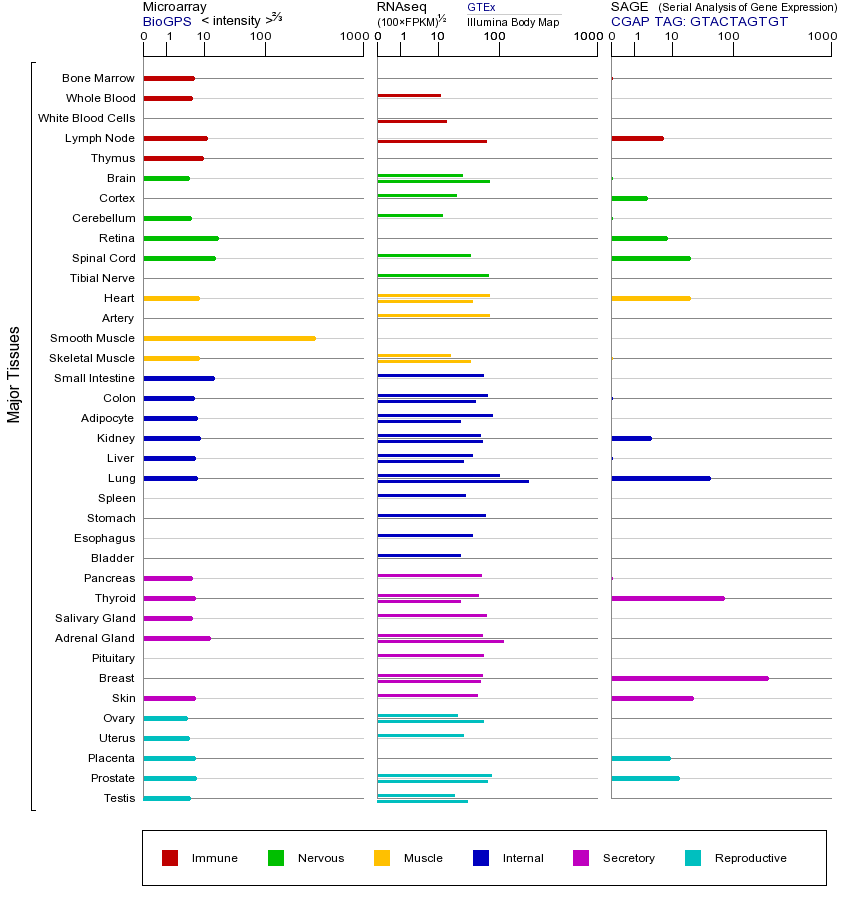CCL2 (C-C motif chemokine ligand 2)
- symbol:
- CCL2
- locus group:
- protein-coding gene
- location:
- 17q12
- gene_family:
- Chemokine ligands|Endogenous ligands
- alias symbol:
- MCP1|MCP-1|MCAF|SMC-CF|GDCF-2|HC11|MGC9434
- alias name:
- monocyte chemotactic protein 1, ho…
- entrez id:
- 6347
- ensembl gene id:
- ENSG00000108691
- ucsc gene id:
- uc002hhy.4
- refseq accession:
- NM_002982
- hgnc_id:
- HGNC:10618
- approved reserved:
- 1990-07-05
CCL2(Chemokine (C-C motif) ligand 2,趋化因子配体2)是一种由人类基因CCL2编码的小分子分泌蛋白,属于CC类趋化因子家族(CC chemokine family)。该家族成员的特征是含有两个相邻的半胱氨酸(Cysteine)残基(即CC基序),主要功能是通过与G蛋白偶联受体结合来招募免疫细胞(如单核细胞、T细胞等)到炎症或感染部位。CCL2也被称为单核细胞趋化蛋白-1(MCP-1),其生物学功能集中在介导炎症反应和免疫调节。CCL2通过结合其受体CCR2(CC chemokine receptor 2)发挥作用,主要影响单核细胞、记忆T细胞和树突细胞的迁移。在正常生理状态下,CCL2参与组织修复和免疫监视,但在病理条件下,其异常表达与多种疾病相关。例如,CCL2过表达会加剧慢性炎症性疾病(如类风湿性关节炎、动脉粥样硬化)、癌症(促进肿瘤微环境中免疫抑制和转移)和神经退行性疾病(如阿尔茨海默病,通过激活小胶质细胞导致神经炎症)。相反,CCL2表达降低可能削弱免疫细胞招募能力,增加感染风险或延缓伤口愈合。CCL2基因突变可能影响其蛋白结构或表达水平,导致功能异常。例如,某些突变会增强其趋化活性,加剧炎症;而另一些突变可能导致功能丧失,与免疫缺陷相关。在基因家族层面,CC类趋化因子(如CCL3、CCL4、CCL5等)均通过类似机制调控免疫细胞迁移,但各自靶向不同细胞类型或受体。CCL2的过表达还可能通过激活下游信号通路(如NF-κB)间接影响其他炎症相关基因(如IL-6、TNF-α),形成促炎反馈循环;而抑制其表达则可能减轻病理损伤,但需注意对正常免疫功能的潜在干扰。
This gene is one of several cytokine genes clustered on the q-arm of chromosome 17. Chemokines are a superfamily of secreted proteins involved in immunoregulatory and inflammatory processes. The superfamily is divided into four subfamilies based on the arrangement of N-terminal cysteine residues of the mature peptide. This chemokine is a member of the CC subfamily which is characterized by two adjacent cysteine residues. This cytokine displays chemotactic activity for monocytes and basophils but not for neutrophils or eosinophils. It has been implicated in the pathogenesis of diseases characterized by monocytic infiltrates, like psoriasis, rheumatoid arthritis and atherosclerosis. It binds to chemokine receptors CCR2 and CCR4. [provided by RefSeq, Jul 2013]
该基因是聚集在17号染色??体的q臂上趋化因子是参与免疫调节和炎症过程的分泌蛋白的超家族的几个细胞因子基因之一。该超家族分为基于成熟的肽的N-末端半胱氨酸残基的排列四个亚科。该趋化因子为CC亚科其特征在于两个相邻的半胱氨酸残基中的一员。这种细胞因子显示单核细胞和嗜碱性粒细胞,但不为嗜中性粒细胞或嗜酸性粒细胞趋化活性。它已牵涉的特征在于单核细胞浸润,如牛皮癣,类风湿性关节炎和动脉粥样硬化性疾病的发病机制。它结合趋化因子受体CCR2和CCR4。 [由RefSeq的,2013年7月提供]
基因本体信息
CCL2基因(以及对应的蛋白质)的细胞分布位置:
- 质膜
- 细胞质
- 细胞外
- 高尔基体
- 囊泡
- 细胞骨架
- 内质网
- 细胞核
- 内体
- 溶酶体
- 线粒体
CCL2基因的本体(GO)信息:
| 名称 |
|---|
| 4668 TNF signaling pathway [PATH:hsa04668] |
| 4060 Cytokine-cytokine receptor interaction [PATH:hsa04060] |
| 4621 NOD-like receptor signaling pathway [PATH:hsa04621] |
| 4062 Chemokine signaling pathway [PATH:hsa04062] |
| 5323 Rheumatoid arthritis [PATH:hsa05323] |
| 5164 Influenza A [PATH:hsa05164] |
| 5168 Herpes simplex infection [PATH:hsa05168] |
| 5144 Malaria [PATH:hsa05144] |
| 5142 Chagas disease (American trypanosomiasis) [PATH:hsa05142] |
| 名称 |
|---|
| ATF4 activates genes |
| Chemokine receptors bind chemokines |
| Class A/1 (Rhodopsin-like receptors) |
| GPCR ligand binding |
| Metabolism of proteins |
| Peptide ligand-binding receptors |
| PERK regulates gene expression |
| Signal Transduction |
| Signaling by GPCR |
| Unfolded Protein Response (UPR) |
| 疾病名称 | 关系值 | NofPmids | NofSnps | 来源 |
| Brain Ischemia | 0.28 | 3 | 0 | CTD_human_CTD_mouse_RGD |
| MYCOBACTERIUM TUBERCULOSIS, SUSCEPTIBILITY TO (finding) | 0.24 | 0 | 1 | CLINVAR_CTD_human |
| Inflammation | 0.225099593 | 14 | 0 | CTD_human_GAD_LHGDN_RGD |
| Coronary Artery Disease | 0.22088855 | 26 | 1 | BeFree_CTD_human_GAD_LHGDN_RGD |
| Asthma | 0.214278137 | 13 | 0 | BeFree_CTD_human_GAD_RGD |
| Hypertensive disease | 0.209001189 | 11 | 0 | BeFree_CTD_human_GAD_RGD |
| Kidney Failure, Chronic | 0.207262917 | 11 | 6 | BeFree_CTD_human_GAD_LHGDN_RGD |
| Diabetic Nephropathy | 0.20706742 | 19 | 2 | BeFree_CTD_human_LHGDN_RGD |
| Myocardial Ischemia | 0.206091273 | 7 | 0 | BeFree_CTD_human_GAD_RGD |
| Pulmonary Fibrosis | 0.203810118 | 9 | 0 | BeFree_CTD_human_LHGDN_RGD |
联系方式
山东省济南市章丘区文博路2号 齐鲁师范学院 genelibs生信实验室
山东省济南市高新区舜华路750号大学科技园北区F座4单元2楼
电话: 0531-88819269
E-mail: product@genelibs.com
微信公众号
关注微信订阅号,实时查看信息,关注医学生物学动态。







